Wszystkiego dobrego – oby ten nowy, 2015 rok nie był gorszy, nadal ciekawy, wypełniony pozytywnymi emocjami, szybko pozwalający zapomnieć gorsze momenty. Życzyłbym Andrzejowi i sobie oraz Fundacjom, dla których zbieramy pieniądze, abyśmy dotarli na metę w Ustrzykach Górnych, a na blogu, w czerwcu była długa lista tych, którzy chcą pomóc. Z drugiej strony marzyłbym, by lista tych, którzy czekają na tę pomoc skracała się – niestety jest odwrotnie i nie zależy to od wyniku, który osiągniemy.
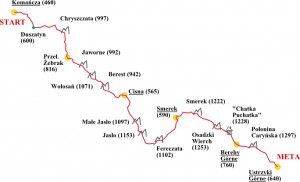
Latem na miejskich ścieżkach biegowych często widać takie oto obrazki – leginsy, kolorowa bluza, oczywiście biegowa, na ramieniu przyczepiony smartfon, od którego kabelki prowadzą muzyczkę do uszu – płeć bez znaczenia. No i najważniejsze – ten wspaniały krok, solidnie wyprowadzone kolano do góry, silne tylne odbicie i piękna faza lotu. Lądowanie na wysuniętą – najdalej jak się da – nogę, a w zasadzie piętę i powtórka z częstotliwością prawie 60x na minutę – sarna, jeleń? Trzasku kości nie słychać, bo ludzie wymyślili amortyzowane buty sportowe i sprzedają je chwaląc głównie tę zaletę. Zwróciłem kiedyś uwagę na reklamę Adidasa – film pokazuje bardzo długi krok i fantastyczną amortyzację pięty, a jest ona konieczna, gdyż biegacz systematycznie nadziewa się na nogę wykroczną.
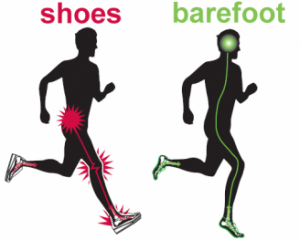
Nooo .. coś jest nie tak. Sam wiem, że po 200km takiego biegu jak na reklamowym filmie można rezerwować kolejkę do ortopedy. Początkujący biegacze, właśnie z powodu zbyt długiego kroku, dość szybko zaczynają odczuwać ból w kolanach, później i w pasie biodrowym. Jest inna metoda – naturalnego biegania, która stara się przywrócić prawidłową postawę i pełną amortyzację jaką ma nasze ciało – czyli układ stopy, kolana, bioder. W butach podbicie i śródstopie są ściśnięte i nie pracują, lądujemy na osłoniętej pięcie, która nie alarmuje bólem, więc każdy jogging i np. 15 tysięcy kroków prawie na prostych nogach, rozwala kolana i biodra. Zwolennicy tej teorii zalecają bieganie boso, albo w specjalnych skarpetach biegowych, bez żadnej amortyzacji, tak jak pierwotni ludzie.
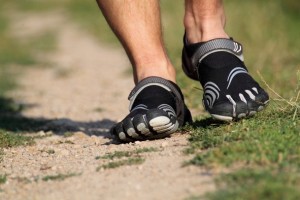
Zgadza się, ta metoda koryguje, ponieważ na betonie, boso, nie pobiegniesz długim krokiem przez piętę. Wszystko fajnie, ale oni biegali w innym klimacie i ważyli połowę mniej. Oczywiście jest i złoty środek – biegać przez śródstopie w dobrze wybieganych butach, które straciły amortyzację. Tu przeciwnicy uważają, że stary but ma już uformowane odkształcenia, które pogłębiają nasze wady i też jest źle. Podkreślają, że buty biegowe trzeba wymieniać co ok. 1000km – bądź tu mądry. A zgubisz się zupełnie gdy uświadomisz sobie, że najlepiej biegające plemię Tarachumara (Górny Meksyk), z którym próbują mierzyć się najlepsi wśród wśród ultrasów, biega w … sandałach. Czasem jest to sznurek i kawałek wycięty ze starej opony.
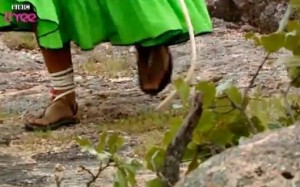
Andrzej korzysta z Brooksów Cascadia – świetny but trialowy zaprojektowany przez Scotta Jurka, jednego z najlepszych ultrasów na świecie. Ja biegam w Sauconach, jak się okazało takich samych jak Wojtek. Raczej korzystamy z butów, które dadzą radę na zbiegach, w błocie, czy na kamieniach.
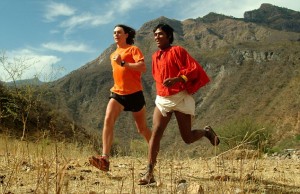
Źródło: Urodzeni biegacze
Z pewnością jest tak, że buty, również samochody, autobusy, schody ruchome, powodują, że tracimy sprawność wspaniałego resoru – stopa, kolano, biodro – z resztą, nie tylko tego. To co robić?
Skróć krok, postaw nogę pod sobą a nie przed sobą i takim truchtem w kadencji 90 (90kroków/min) dobiegniesz znacznie dalej. Po bieganiu nie zapomnij o rozciąganiu.
Tomek
ENG: translation Anna Meysztowicz
Best wishes – may this new year 2015 be as good as, interesting, full of positive emotions and quickly enable you to forget any worse moments. I would wish for myself and Andrzej, as well as the foundations that we are fundraising for, to reach our goal in Ustrzyki Górne, and on the blog, in June, for there to be a long list of those willing to help. On the other hand I would dream for the list of those in need to shorten – unfortunately the opposite is happening and has nothing to do with our achievements.
In summer on city running tracks we often see these images – leggings, a colourful sweater (naturally a running sweater), a smartphone attached to the upper arm, with earphones providing music to the ears, regardless of the gender of the runner. And the most important aspect – that fantastic step, leading the knee up high, a strong rebound and a beautiful flight phase. Landing on an outstretched (as far as it will go) leg, or actually rather heel, and repeat at a frequency of nearly 60 x per minute – a doe, a deer? You cannot hear the cracking bones, because humans invented shock absorbing sports shoes and sell them chiefly promoting this value. I once noticed an Adidas add – the clip shows a very long step and fantastic shock absorption of the heel, and that is necessary since the runner is systematically spearing himself on an outstretched leg
Well… something is not right. I know myself that, after 200 km of such running as exemplified on the advertisement, you can take your place in the queue for the orthopaedic surgeon. Beginner runners, precisely due to an overly elongated step, quite quickly begin to feel pain in the knees, and later in the hip area. There is another method – natural running, which attempts to restore the proper posture and full shock absorption that our body has – i.e. the foot, knee and hip system. In running shoes, the instep and metatarsus are squashed and don’t work, we land on our exposed heel, which does not alarm us with pain so every jogging session and, for example, 15 thousand steps on nearly straight legs, shatters our knees and hips. Supporters of this theory recommend running barefoot, or in special running socks, that don’t have shock absorption, just like the primitive man.
It’s true that this method rectifies our running technique as on the concrete, barefoot, you won’t run using a long step and landing on the heel. This is all well and good but they ran in a different climate and weighed half as much as we do. Naturally there is a happy medium – run using the metatarsus in well-used shoes that have lost their shock absorbing properties. Opponents here believe that a shoe has pre-formed moulds that worsen our flaws and that this is no good either. They stress that running shoes should be changed approximately every 1,000 km – now you be smart and make your choice. And you will get completely lost if you realise that the best running tribe, the Tarahumara (from North Mexico), with whom the best of the best ultramarathon runners try to compete, run in… sandals. Sometimes these are just some string and a piece of rubber cut from an old tyre.
Tarahumara or Raramuri. They run at all ages for distances of 50 km over mountain terrain without any problems
Andrzej wears Brooks Cascadia – an excellent triathlon shoe designed by Scott Jurek, one of the world’s best ultramarathon runners. I wear Saucony shoes, the same ones as Wojtek incidentally. We tend to use shoes that will manage on muddy or rocky terrain.
Certainly shoes, as well as cars, buses and escalators, mean that we lose the ability of our own magnificent resource – the foot, the knee and the hip – and not just this, either. What to do then?
Step by step, place your legs under you and not in front of you and, like this, over 90 steps/min you will run much further. When you’ve finished running, don’t forget to stretch.
Tomek